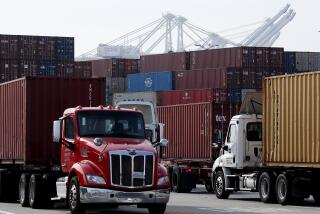Exxon Tanker Involved in Alaskan Oil Spill Returns to Water : Shipping: The repaired and renamed Exxon Valdez will head out on its first assignment, to pick up oil in the Middle East and carry it to Europe.
- Share via
After nearly a year at dry dock in San Diego Bay, the Exxon tanker involved in the nation’s worst oil spill returned to water Friday night following massive, multimillion-dollar repairs.
Towed by four tugboats, the Exxon Mediterranean, formerly christened the Exxon Valdez, was floated out of its dry dock for the the first time and moved into the bay. It was escorted a quarter mile to an outfitting pier, where it was berthed to undergo 10 days of equipment checks and other tests to evaluate the tanker’s seaworthiness. A two-week sea trial, scheduled for early August, will follow.
“Today’s refloating is a significant milestone in the return of this vessel to service,” said Robert Weatherford, Exxon Shipping Co. business and planning manager, during a news conference held aboard the repaired tanker Friday.
Fred Hallett, chief financial officer at National Steel & Shipbuilding Co., said shipyard workers began the 24-hour process of flooding the dry dock Thursday. Once the water level reached the same height as the bay Friday night, the gate of the dry dock was opened. He said the tanker was released and slowly floated out.
The gray and red tanker, 987 feet long and 166 feet wide, is now docked at Nassco’s Pier 6, just south of the Coronado Bridge.
The ship has undergone major repairs since last September to its single-skin steel hull at the Nassco shipyard, where it was built in 1986. When the damaged ship docked at Nassco, officials said whole sheets of the tanker’s skin on the starboard side appeared shredded, twisted and crumpled, as if it were flimsy aluminum, not steel three-quarters of an inch thick.
Cosmetic changes to the tanker included the words “Exxon Mediterranean” freshly painted on the ship’s stern and a new coat of dark red paint on its reconstructed hull.
The tanker, repaired to its “original construction,” is tentatively scheduled to make its first voyage to the Middle East in mid- to late August, Weatherford said.
Friday morning, reporters were invited by Exxon and Nassco officials aboard the ship’s bridge for the first time since the tanker spilled 11-million gallons of crude oil into Alaska’s Prince William Sound in March, 1989. It was towed into San Diego Bay last July for a $30-million repair job at Nassco.
“Everything was on schedule and on budget,” Nassco president Richard Vortmann said. “Nothing of this magnitude has ever been done before, so this was a tremendous technical engineering feat.”
Exxon spokesman Tom Gillette said one-third of the tanker’s bottom was repaired or replaced, a process that used 3,000 tons of steel. He said that final repairs on the 3-year-old, highly automated tanker were completed last week, and the ship is in “tiptop” shape.
“I can finally get back to what I was trained to do,” said Capt. Mike Stalzer, who will captain the ship during the sea trial and its first assignment to the Middle East. He earlier served as a captain on the Valdez, but was off duty at the time of the oil spill.
Exxon Shipping Co. President Gus Elmer announced the tanker’s new route, which will be outside U.S. waters, and its new name earlier this month. He said the tanker will load Middle Eastern oil in the Mediterranean and deliver it to Europe, becoming the first U.S.-licensed tanker to enter foreign service.
Stalzer, 39, said the Mediterranean’s first voyage will probably include a stop in Singapore to refuel.
The Mediterranean’s new route, Gillette said, will probably include loading at single-port moorings off Turkey and Egypt and making stops at Trieste in Italy, Marseille in southern France, Port Jerome in western France and Rotterdam in the Netherlands.
“We won’t leave here until everything is tested and we’re thoroughly satisfied,” Stalzer said, noting that the engine room machinery, navigational system, radars and other state-of-the-art equipment on board will be tested during the two-week trial run, which will be held outside traffic lanes 100 to 150 miles offshore.
Coast Guard and American Bureau of Shipping inspectors will accompany Stalzer and his 20-member crew on the repaired tanker’s trial run, said Paul Meyers, project manager for Exxon. He said the tanker, one of the largest in Exxon’s 13-ship American fleet, will renew its Coast Guard two-year certification as a seaworthy vessel during the test run.
As the Valdez, the tanker, outfitted with a 4-foot-deep, 8-by-12-foot swimming pool, was designed to travel from Alaska to Panama, along with sister ship Exxon Long Beach. Exxon no longer trades in Panama and delivers Alaskan oil exclusively to the U.S. West Coast. Gillette said the decline in Alaskan crude production prompted Exxon officials to reassign the 30,000-ton tanker to the Middle East route.
Exxon officials denied the tanker’s name and route were changed as a public relations ploy. They also stood by the company’s decision not to equip the tanker with a double hull.
Nassco officials said the 300 pipe fitters, carpenters, electricians, welders and painters who were employed to fix the Mediterranean have already been reassigned to other projects at Nassco’s shipyard.
More to Read
Sign up for Essential California
The most important California stories and recommendations in your inbox every morning.
You may occasionally receive promotional content from the Los Angeles Times.












